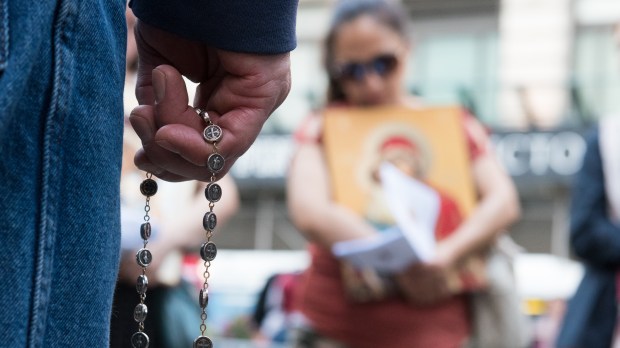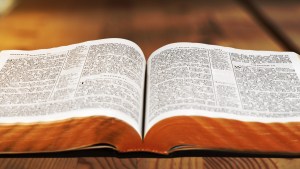Thank you to readers who appreciatd the Joseph Rosary, and the Luminous Mysteries Doctrinal Rosary pointing to basics of the faith.
St. Pope John Paul II, St. Pope Paul VI, and St. Louis Marie de Montfort all recommend adding descriptors after “Jesus” in the Hail Mary to enrich the rosary. For instance:
Agony in the Garden: “… and blessed is the fruit of thy womb Jesus, in agony for our sins. Holy Mary, Mother of God …”
I included a guide to each mystery in my book The Rosary of Saint John Paul II. Since then, my family expanded the practice to highlight key doctrines. Here is what we add after Jesus in the Joyful mysteries to teach about who Christ is, the significance of his incarnation, our duties, and the identity of his Church.
The First Joyful Mystery, the Annunciation
Mary’s Yes to God through the angel Gabriel brought about the incarnation, God becoming man.
… Jesus, “the Only Begotten Son of God, born of the Father before all ages.”
… Jesus, “God from God, Light from Light, true God from true God.”
… Jesus, “begotten, not made, consubstantial with the Father.”
… Jesus, “through [whom] all things were made.”
… Jesus, who “came down from heaven.”
… Jesus, who “by the Holy Spirit was incarnate of the Virgin Mary.”
… Jesus, who was “God, infinitely perfect and blessed in himself.” (CCC, 1)
… Jesus, through whom God “created man to make him share in his own blessed life.” (CCC 1)
… Jesus, who “when the fullness of time had come … was sent as Redeemer and Savior.” (CCC 1)
… Jesus, who invites us to be “his adopted children and thus heirs of his blessed life.” (CCC 1)
The Second Joyful Mystery, the Visitation
Mary goes in haste to serve Elizabeth, a model of the corporal works of mercy united with Jesus.
… Jesus, whose greatest commandment is “You shall love the Lord your God with all your heart, with all your soul, and with all your mind.” (cf. Mt 22:37-38)
…. Jesus who said “a second [commandment] is like it: You shall love your neighbor as yourself.” (Mt 22:39)
… Jesus, who said “whatever you did for one of these least brothers of mine, you did it for me.” (Mt 25:40)
… Jesus, whose first corporal work of mercy is to feed the hungry.
… Jesus, whose second corporal work of mercy is to give drink to the thirsty.
… Jesus, whose third corporal work of mercy is to clothe the naked.
… Jesus, whose fourth corporal work of mercy is to shelter the homeless.
… Jesus, whose fifth corporal work of mercy is to visit the sick.
… Jesus, whose sixth corporal work of mercy is to visit the imprisoned.
… Jesus, whose seventh corporal work of mercy is to bury the dead.
The Third Joyful Mystery, the Nativity
Jesus’ birth in Bethlehem showed the emergence of Emmanuel, God-with-us, into our world.
… Jesus, of whom St. Paul writes “when the time had fully come, God sent forth his Son, born of a woman” (Gal. 4:4; cf CCC 422)
… Jesus, whose name means “God saves” (CCC 452)
… Jesus, whose title Christ means “Anointed One, Messiah” (CCC 453)
… Jesus, whose title Son of God means “he is the only Son of the Father; he is God himself.” (CCC 454)
… Jesus, “who possesses two natures, one divine and the other human” (CCC 481).
… Jesus whose two natures are “united in the one person of God’s Son” (CCC 481).
… Jesus, at whose nativity “man’s Creator has become man, born of the Virgin.” (CCC 526)
… Jesus, who made you, Mary, “truly ‘Mother of God’ since [you are] the mother of the eternal Son of God made man.” (CCC 509)
… Jesus, for whom you, Mary, “remained a virgin in conceiving [him], a virgin in giving birth to him, a virgin in carrying him, a virgin in nursing him … always a virgin” (CCC 510).
… Jesus, who the magi showed to be “Messiah of Israel, Son of God, and Savior of the world.” (CCC 528)
The Fourth Joyful Mystery, the Presentation in the Temple
The Holy Family’s presentation of Jesus in the temple is a model for our sacramental life.
… Jesus who gave us three sacraments of Christian initiation so we can receive new life in Christ. (CCC 1420)
… Jesus, who, in baptism “purifies [us] from all sins,” makes us a “new creature” and “partakers of the divine nature.” (CCC 1265)
… Jesus, who, in Confirmation, “gives us a special strength of the Holy Spirit to spread and defend the faith by word and action as true witnesses of Christ.” (CCC 1303).
… Jesus, who is truly present in the Eucharist, which, when received in a state of grace, increases our union with the Lord. (CCC 1416)
… Jesus, who gave us two Sacraments of Healing for the Church to continue on earth his mission to heal and save. (CCC 1421)
… Jesus, who, in confession reconciles us with God, recovers the state of grace, remits punishment for sin and increases our serenity and spiritual strength. (CCC 1496)
… Jesus, who, in the Anointing of the Sick prepares us for eternal life, forgives sins if confession is impossible and restores health if it is conducive to salvation. (CCC 1532)
… Jesus, who gives us two Sacraments of Communion and Mission to serve and build up the People of God. (CCC 1534)
… Jesus, who, in Holy Orders gives us deacons and priests “to feed the Church by the word and grace of God.” (CCC 1535)
… Jesus, who bonds couples in marriage for “the good of the spouses and the procreation and education of offspring.” (CCC 1601)
The Fifth Joyful Mystery, the Finding in the Temple
The Holy Family, obedient Jews, visit the Temple, modeling our duty to the Church, and direct us to find Christ in the Church.
… Jesus, whose Church is One because the Trinity is its source, Christ is its founder and the Holy Spirit is its soul. (CCC 813)
… Jesus, whose Church is Holy in its means, which are the sacraments, and its end, which is unity with Christ. (CCC 824-825)
… Jesus, whose Church is catholic because she proclaims the fullness of the faith to all peoples and encompasses all times. (CCC 868)
… Jesus, whose Church is apostolic because it was founded on Peter and the apostles and is governed by their successors. (CCC 857)
… Jesus, whose Church gives five precepts “to guarantee for the faithful the indispensable minimum” for growth in love of God and neighbor. (Compendium of the Catechism, 431)
… Jesus, whose Church’s first precept is: “You shall attend Mass on Sundays and on holy days of obligation and remain free from work or activity that could impede the sanctification of such days.”
… Jesus, whose Church’s second precept is: “You shall confess your sins at least once a year.”
… Jesus, whose Church’s third precept is: “You shall receive the sacrament of the Eucharist at least during the Easter season.”
… Jesus, whose Church’s fourth precept is: “You shall observe the prescribed days of fasting and abstinence established by the Church.”
… Jesus, whose Church’s fifth precept is: “You shall help to provide for the needs of the Church.” (Precepts from Compendium of the Catechism, appendix)



